Value Chain Analysis of Domino's Pizza Company
VerifiedAdded on 2023/02/01
|16
|4681
|37
AI Summary
This study explores the value chain analysis of Domino's Pizza Company and discusses the allocation of cost by the job costing method and activity based costing method.
Contribute Materials
Your contribution can guide someone’s learning journey. Share your
documents today.

Management accounting
Secure Best Marks with AI Grader
Need help grading? Try our AI Grader for instant feedback on your assignments.
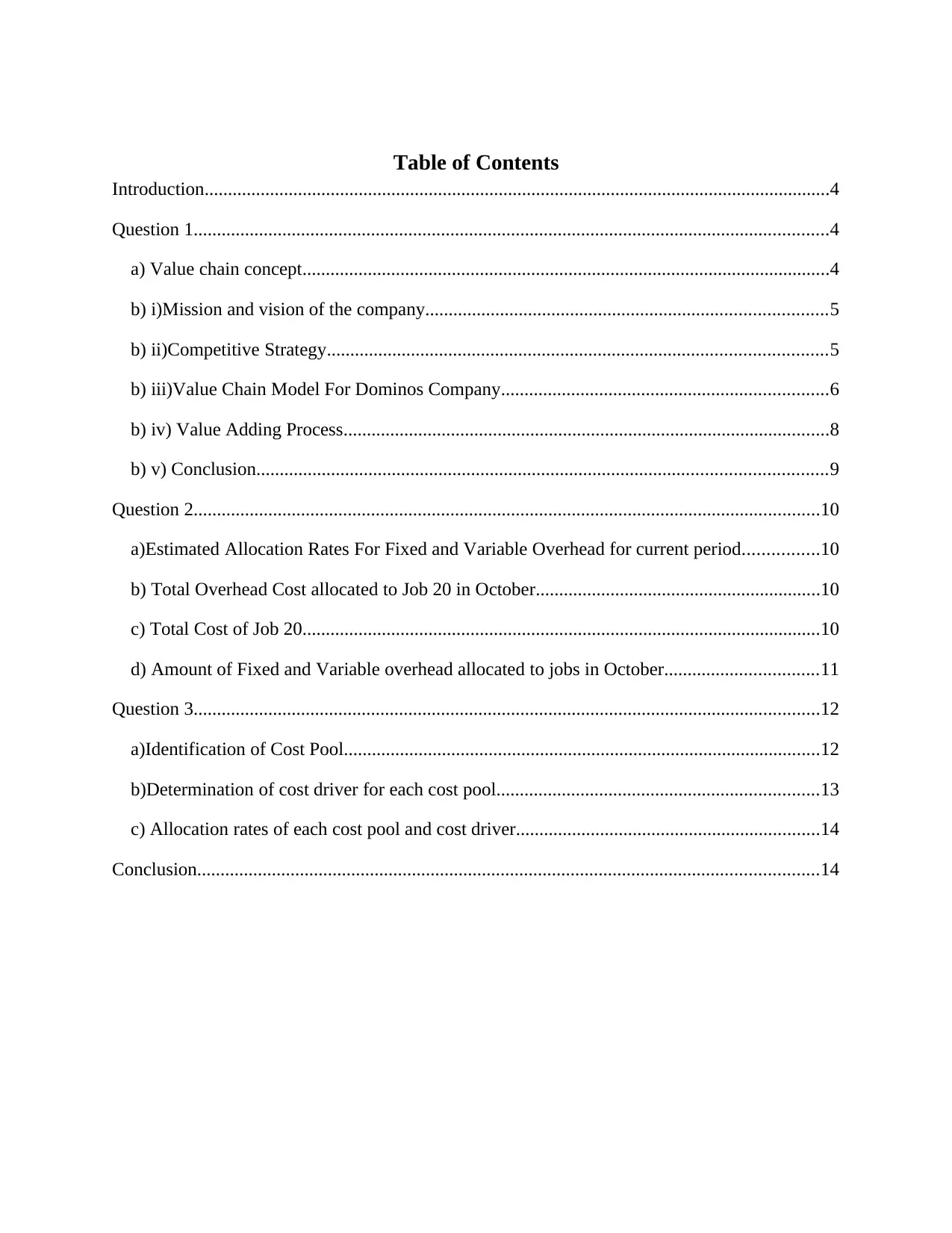
Table of Contents
Introduction......................................................................................................................................4
Question 1........................................................................................................................................4
a) Value chain concept.................................................................................................................4
b) i)Mission and vision of the company......................................................................................5
b) ii)Competitive Strategy...........................................................................................................5
b) iii)Value Chain Model For Dominos Company......................................................................6
b) iv) Value Adding Process........................................................................................................8
b) v) Conclusion..........................................................................................................................9
Question 2......................................................................................................................................10
a)Estimated Allocation Rates For Fixed and Variable Overhead for current period................10
b) Total Overhead Cost allocated to Job 20 in October.............................................................10
c) Total Cost of Job 20...............................................................................................................10
d) Amount of Fixed and Variable overhead allocated to jobs in October.................................11
Question 3......................................................................................................................................12
a)Identification of Cost Pool......................................................................................................12
b)Determination of cost driver for each cost pool.....................................................................13
c) Allocation rates of each cost pool and cost driver.................................................................14
Conclusion.....................................................................................................................................14
Introduction......................................................................................................................................4
Question 1........................................................................................................................................4
a) Value chain concept.................................................................................................................4
b) i)Mission and vision of the company......................................................................................5
b) ii)Competitive Strategy...........................................................................................................5
b) iii)Value Chain Model For Dominos Company......................................................................6
b) iv) Value Adding Process........................................................................................................8
b) v) Conclusion..........................................................................................................................9
Question 2......................................................................................................................................10
a)Estimated Allocation Rates For Fixed and Variable Overhead for current period................10
b) Total Overhead Cost allocated to Job 20 in October.............................................................10
c) Total Cost of Job 20...............................................................................................................10
d) Amount of Fixed and Variable overhead allocated to jobs in October.................................11
Question 3......................................................................................................................................12
a)Identification of Cost Pool......................................................................................................12
b)Determination of cost driver for each cost pool.....................................................................13
c) Allocation rates of each cost pool and cost driver.................................................................14
Conclusion.....................................................................................................................................14

INTRODUCTION
In the present competitive scenario, it is essential for the companies to analyze the internal and
external environment along with buying behavior of consumers by which they can cope up with
the competition. With this aspect, value chain analysis is one of the most important tools by
which company can identify their internal capabilities. The present study shows several aspects
related to the value chain analysis of Domino’s Pizza Company. It is one of the leading
companies in the international market. Further, the study revolves around the allocation of the
cost method. In this study, the allocation of cost by the job costing method and activity based
costing method is also described. In the job costing system, the cost is allocated on the basis of
an individual unit of the output. Further, in the activity based costing, the overhead cost is
allocated on the basis of activity of the company.
QUESTION 1
a) Value chain concept
In the rapidly changing environment, high-quality product is offered by the organizations for
achieving enduring competitiveness. For achieving the objectives, the company has to match and
further go beyond its competitors and should discover the need of the customer and strategise to
fulfil their expectations (Mudambi, and Puck, 2016).
Value chain analysis is a procedure in which company recognize its supportive and important
activities which adds value to its final product and further, examine such activities to decrease
cost or else add to differentiation (da Silva et al. 2017).
The strategic tool of value chain analysis is used to examine the internal activities of the
company. Its major aim is to identify the most valuable activity of the firm and which can be
improved to provide a competitive advantage (Ivanov, 2017). The organized sight of companies
is suggested by the value chain analysis however it steps are included in the process of
transformation by means of outputs and inputs for every different stage (Ou-Yang et al.,2018).
The concept of value chain analysis is majorly based on the fiscal principle of advantage. When
there are more productive advantages in comparison to competitors in that case companies are
In the present competitive scenario, it is essential for the companies to analyze the internal and
external environment along with buying behavior of consumers by which they can cope up with
the competition. With this aspect, value chain analysis is one of the most important tools by
which company can identify their internal capabilities. The present study shows several aspects
related to the value chain analysis of Domino’s Pizza Company. It is one of the leading
companies in the international market. Further, the study revolves around the allocation of the
cost method. In this study, the allocation of cost by the job costing method and activity based
costing method is also described. In the job costing system, the cost is allocated on the basis of
an individual unit of the output. Further, in the activity based costing, the overhead cost is
allocated on the basis of activity of the company.
QUESTION 1
a) Value chain concept
In the rapidly changing environment, high-quality product is offered by the organizations for
achieving enduring competitiveness. For achieving the objectives, the company has to match and
further go beyond its competitors and should discover the need of the customer and strategise to
fulfil their expectations (Mudambi, and Puck, 2016).
Value chain analysis is a procedure in which company recognize its supportive and important
activities which adds value to its final product and further, examine such activities to decrease
cost or else add to differentiation (da Silva et al. 2017).
The strategic tool of value chain analysis is used to examine the internal activities of the
company. Its major aim is to identify the most valuable activity of the firm and which can be
improved to provide a competitive advantage (Ivanov, 2017). The organized sight of companies
is suggested by the value chain analysis however it steps are included in the process of
transformation by means of outputs and inputs for every different stage (Ou-Yang et al.,2018).
The concept of value chain analysis is majorly based on the fiscal principle of advantage. When
there are more productive advantages in comparison to competitors in that case companies are

served outstandingly well. At the same time, companies are supposed to ask themselves how
they can deliver the best value to their clientele. There are various ways in which Value chain
management brings various benefits, like the improved flow of products and material, the
faultless flow of information, and the improved flow of finances (Loving, 2019).
B) i) Mission and vision of the company
The present study is related to Domino’s Pizza Company. It was established in the year 1960, as
American Pizza Restaurant Chain. Headquarter of the company is situated in the United States.
The company holds the seventh position with respect to a number of locations across the world
of their their fast food restaurant chain.
The major aim of the company is to become the world’s best pizza delivery company. Except
this, they made efforts to develop their workers and cater their customers to achieve greater
benefits. In Mexico, they want to maintain high standards of a global chain of pizza delivery.
They want to provide the best experience to the customers in addition to outstanding customer
services (Khakzad, 2015).
Revised Mission Statement: the focus of the organization is to uphold outstanding brand loyalty
and well-organized customer service, throughout remarkable franchisees, and ground-breaking/
competent delivery, while satisfying and rising employees within a fun ambience (Khakzad et
al., 2016). It has been analyzed from the past experience that Domino's the first choice for pizza
around the world. They are focusing on being the best pizza operator with skilled talent. They
want to be number one in people as well as pizza. They don’t want to be ordinary are working to
be exceptional (Bevilacqua et al., 2018).
b) Ii) Competitive Strategy
It is important for an organization to have operational plans to compete in the market as well as
to achieve its strategic plans in consideration with its planned requirement. Before making the
strategic plans, it is essential for an organization to have an accurate organizational audit
(Landucci et al. 2018). Market segment of dominos is kept on changing like it enterers in the
market of Europe which is different from the market of Australia, and there is no similarity in
they can deliver the best value to their clientele. There are various ways in which Value chain
management brings various benefits, like the improved flow of products and material, the
faultless flow of information, and the improved flow of finances (Loving, 2019).
B) i) Mission and vision of the company
The present study is related to Domino’s Pizza Company. It was established in the year 1960, as
American Pizza Restaurant Chain. Headquarter of the company is situated in the United States.
The company holds the seventh position with respect to a number of locations across the world
of their their fast food restaurant chain.
The major aim of the company is to become the world’s best pizza delivery company. Except
this, they made efforts to develop their workers and cater their customers to achieve greater
benefits. In Mexico, they want to maintain high standards of a global chain of pizza delivery.
They want to provide the best experience to the customers in addition to outstanding customer
services (Khakzad, 2015).
Revised Mission Statement: the focus of the organization is to uphold outstanding brand loyalty
and well-organized customer service, throughout remarkable franchisees, and ground-breaking/
competent delivery, while satisfying and rising employees within a fun ambience (Khakzad et
al., 2016). It has been analyzed from the past experience that Domino's the first choice for pizza
around the world. They are focusing on being the best pizza operator with skilled talent. They
want to be number one in people as well as pizza. They don’t want to be ordinary are working to
be exceptional (Bevilacqua et al., 2018).
b) Ii) Competitive Strategy
It is important for an organization to have operational plans to compete in the market as well as
to achieve its strategic plans in consideration with its planned requirement. Before making the
strategic plans, it is essential for an organization to have an accurate organizational audit
(Landucci et al. 2018). Market segment of dominos is kept on changing like it enterers in the
market of Europe which is different from the market of Australia, and there is no similarity in
Secure Best Marks with AI Grader
Need help grading? Try our AI Grader for instant feedback on your assignments.
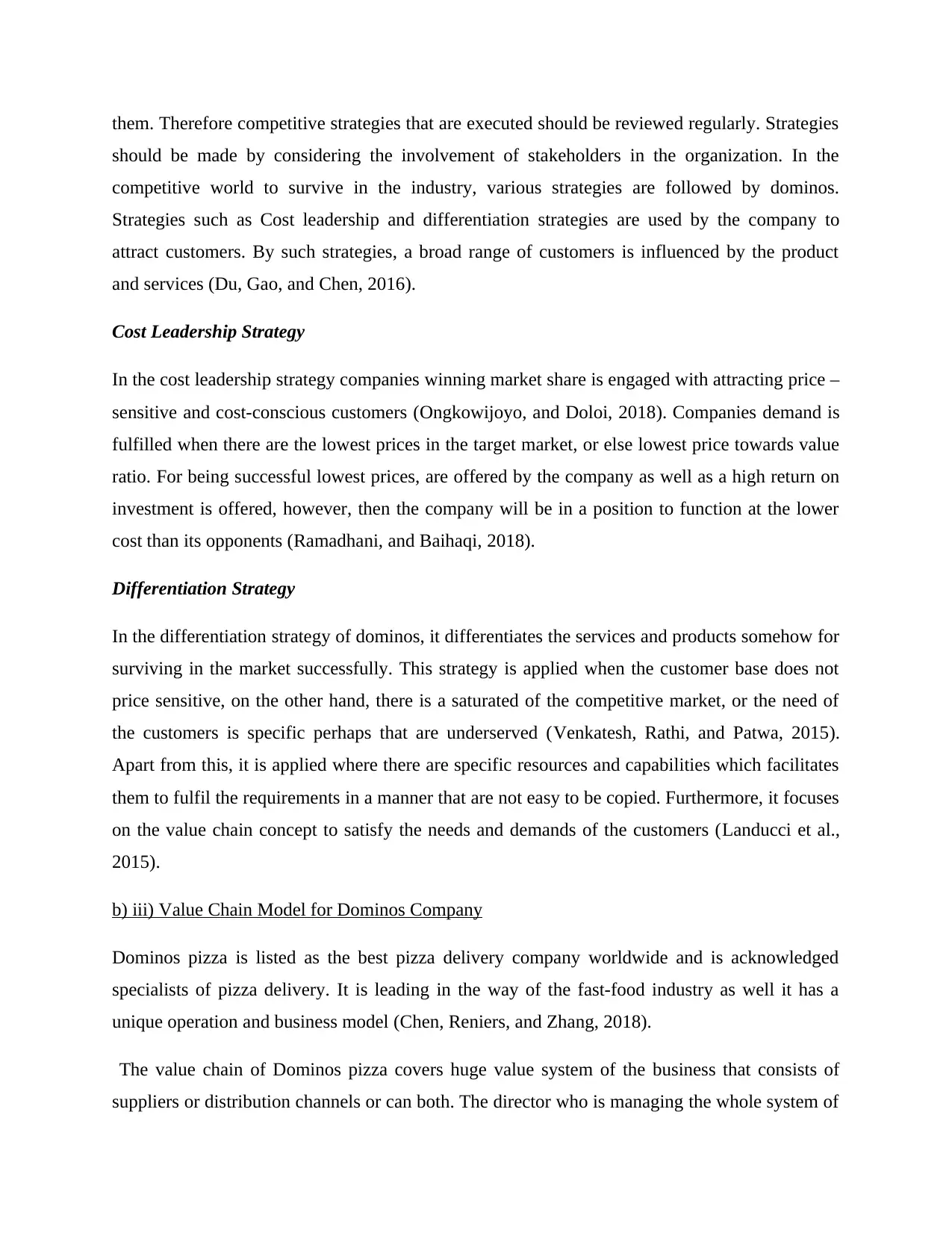
them. Therefore competitive strategies that are executed should be reviewed regularly. Strategies
should be made by considering the involvement of stakeholders in the organization. In the
competitive world to survive in the industry, various strategies are followed by dominos.
Strategies such as Cost leadership and differentiation strategies are used by the company to
attract customers. By such strategies, a broad range of customers is influenced by the product
and services (Du, Gao, and Chen, 2016).
Cost Leadership Strategy
In the cost leadership strategy companies winning market share is engaged with attracting price –
sensitive and cost-conscious customers (Ongkowijoyo, and Doloi, 2018). Companies demand is
fulfilled when there are the lowest prices in the target market, or else lowest price towards value
ratio. For being successful lowest prices, are offered by the company as well as a high return on
investment is offered, however, then the company will be in a position to function at the lower
cost than its opponents (Ramadhani, and Baihaqi, 2018).
Differentiation Strategy
In the differentiation strategy of dominos, it differentiates the services and products somehow for
surviving in the market successfully. This strategy is applied when the customer base does not
price sensitive, on the other hand, there is a saturated of the competitive market, or the need of
the customers is specific perhaps that are underserved (Venkatesh, Rathi, and Patwa, 2015).
Apart from this, it is applied where there are specific resources and capabilities which facilitates
them to fulfil the requirements in a manner that are not easy to be copied. Furthermore, it focuses
on the value chain concept to satisfy the needs and demands of the customers (Landucci et al.,
2015).
b) iii) Value Chain Model for Dominos Company
Dominos pizza is listed as the best pizza delivery company worldwide and is acknowledged
specialists of pizza delivery. It is leading in the way of the fast-food industry as well it has a
unique operation and business model (Chen, Reniers, and Zhang, 2018).
The value chain of Dominos pizza covers huge value system of the business that consists of
suppliers or distribution channels or can both. The director who is managing the whole system of
should be made by considering the involvement of stakeholders in the organization. In the
competitive world to survive in the industry, various strategies are followed by dominos.
Strategies such as Cost leadership and differentiation strategies are used by the company to
attract customers. By such strategies, a broad range of customers is influenced by the product
and services (Du, Gao, and Chen, 2016).
Cost Leadership Strategy
In the cost leadership strategy companies winning market share is engaged with attracting price –
sensitive and cost-conscious customers (Ongkowijoyo, and Doloi, 2018). Companies demand is
fulfilled when there are the lowest prices in the target market, or else lowest price towards value
ratio. For being successful lowest prices, are offered by the company as well as a high return on
investment is offered, however, then the company will be in a position to function at the lower
cost than its opponents (Ramadhani, and Baihaqi, 2018).
Differentiation Strategy
In the differentiation strategy of dominos, it differentiates the services and products somehow for
surviving in the market successfully. This strategy is applied when the customer base does not
price sensitive, on the other hand, there is a saturated of the competitive market, or the need of
the customers is specific perhaps that are underserved (Venkatesh, Rathi, and Patwa, 2015).
Apart from this, it is applied where there are specific resources and capabilities which facilitates
them to fulfil the requirements in a manner that are not easy to be copied. Furthermore, it focuses
on the value chain concept to satisfy the needs and demands of the customers (Landucci et al.,
2015).
b) iii) Value Chain Model for Dominos Company
Dominos pizza is listed as the best pizza delivery company worldwide and is acknowledged
specialists of pizza delivery. It is leading in the way of the fast-food industry as well it has a
unique operation and business model (Chen, Reniers, and Zhang, 2018).
The value chain of Dominos pizza covers huge value system of the business that consists of
suppliers or distribution channels or can both. The director who is managing the whole system of

dominos wants to see all the actions as the part of the value system as well as how any actions
are included or excluded effects the dominos Inc value chain. It this procedure conclusion is
made about where to exist in the value system (Zhou, and Reniers, 2018).
In the present report porter’s value chain model is applied which an influential tool of
management which is used by the leaders at dominos pizza (FLUOĞLU et al. 2017). It can be
used to disaggregate the strategic activities of the company and manage them in a manner in
which it can provide a competitive advantage in the organization during higher prices or else
lower costs.
Figure 1: Value chain analysis
(Source: Schoenherr and Speier‐Pero, 2015)
According to the Value Chain model that activities are divided into two categories – supportive
activity and primary activity
Pizza Domino's has been divided into five generic categories of primary activities –
Inbound logistics
are included or excluded effects the dominos Inc value chain. It this procedure conclusion is
made about where to exist in the value system (Zhou, and Reniers, 2018).
In the present report porter’s value chain model is applied which an influential tool of
management which is used by the leaders at dominos pizza (FLUOĞLU et al. 2017). It can be
used to disaggregate the strategic activities of the company and manage them in a manner in
which it can provide a competitive advantage in the organization during higher prices or else
lower costs.
Figure 1: Value chain analysis
(Source: Schoenherr and Speier‐Pero, 2015)
According to the Value Chain model that activities are divided into two categories – supportive
activity and primary activity
Pizza Domino's has been divided into five generic categories of primary activities –
Inbound logistics
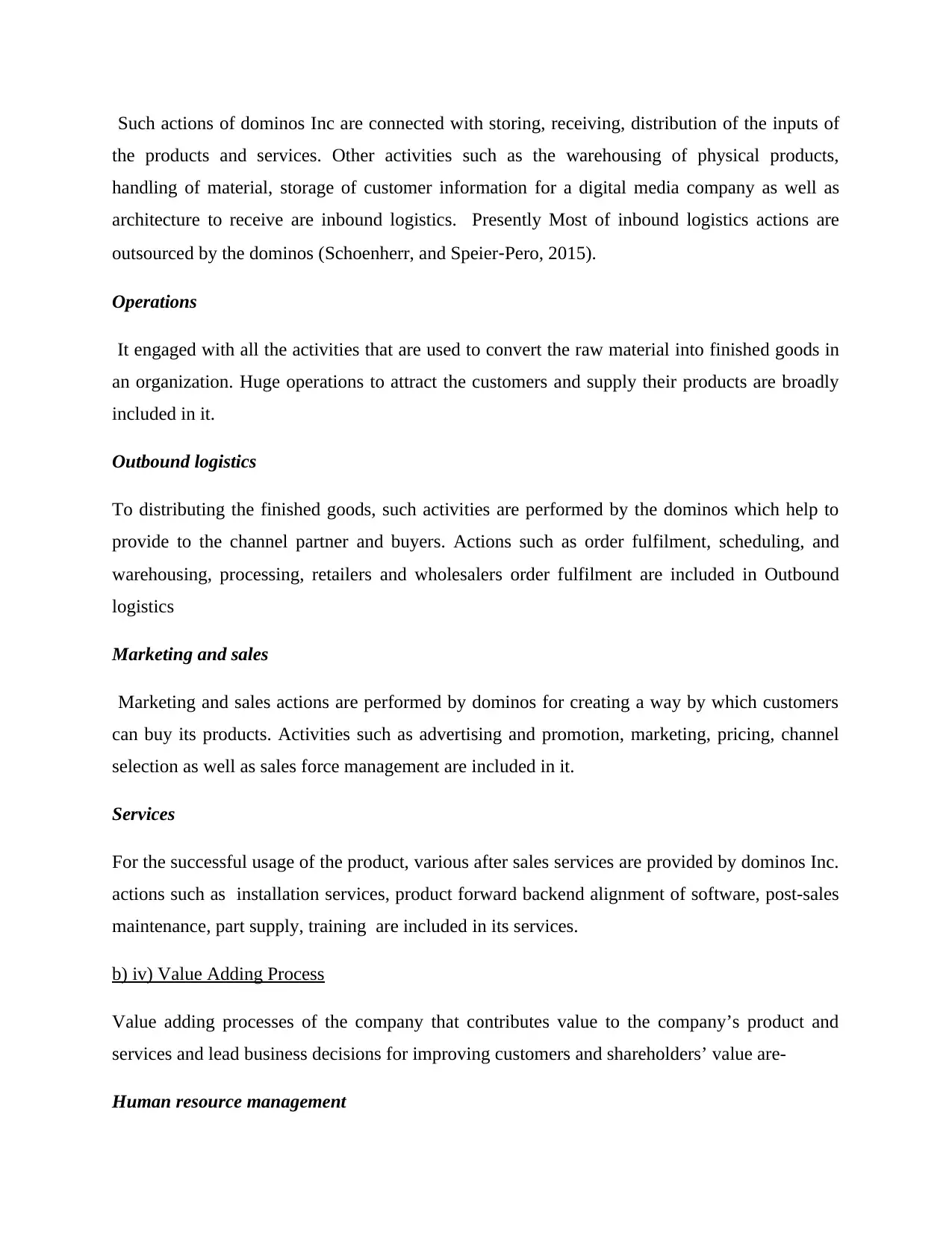
Such actions of dominos Inc are connected with storing, receiving, distribution of the inputs of
the products and services. Other activities such as the warehousing of physical products,
handling of material, storage of customer information for a digital media company as well as
architecture to receive are inbound logistics. Presently Most of inbound logistics actions are
outsourced by the dominos (Schoenherr, and Speier‐Pero, 2015).
Operations
It engaged with all the activities that are used to convert the raw material into finished goods in
an organization. Huge operations to attract the customers and supply their products are broadly
included in it.
Outbound logistics
To distributing the finished goods, such activities are performed by the dominos which help to
provide to the channel partner and buyers. Actions such as order fulfilment, scheduling, and
warehousing, processing, retailers and wholesalers order fulfilment are included in Outbound
logistics
Marketing and sales
Marketing and sales actions are performed by dominos for creating a way by which customers
can buy its products. Activities such as advertising and promotion, marketing, pricing, channel
selection as well as sales force management are included in it.
Services
For the successful usage of the product, various after sales services are provided by dominos Inc.
actions such as installation services, product forward backend alignment of software, post-sales
maintenance, part supply, training are included in its services.
b) iv) Value Adding Process
Value adding processes of the company that contributes value to the company’s product and
services and lead business decisions for improving customers and shareholders’ value are-
Human resource management
the products and services. Other activities such as the warehousing of physical products,
handling of material, storage of customer information for a digital media company as well as
architecture to receive are inbound logistics. Presently Most of inbound logistics actions are
outsourced by the dominos (Schoenherr, and Speier‐Pero, 2015).
Operations
It engaged with all the activities that are used to convert the raw material into finished goods in
an organization. Huge operations to attract the customers and supply their products are broadly
included in it.
Outbound logistics
To distributing the finished goods, such activities are performed by the dominos which help to
provide to the channel partner and buyers. Actions such as order fulfilment, scheduling, and
warehousing, processing, retailers and wholesalers order fulfilment are included in Outbound
logistics
Marketing and sales
Marketing and sales actions are performed by dominos for creating a way by which customers
can buy its products. Activities such as advertising and promotion, marketing, pricing, channel
selection as well as sales force management are included in it.
Services
For the successful usage of the product, various after sales services are provided by dominos Inc.
actions such as installation services, product forward backend alignment of software, post-sales
maintenance, part supply, training are included in its services.
b) iv) Value Adding Process
Value adding processes of the company that contributes value to the company’s product and
services and lead business decisions for improving customers and shareholders’ value are-
Human resource management
Paraphrase This Document
Need a fresh take? Get an instant paraphrase of this document with our AI Paraphraser
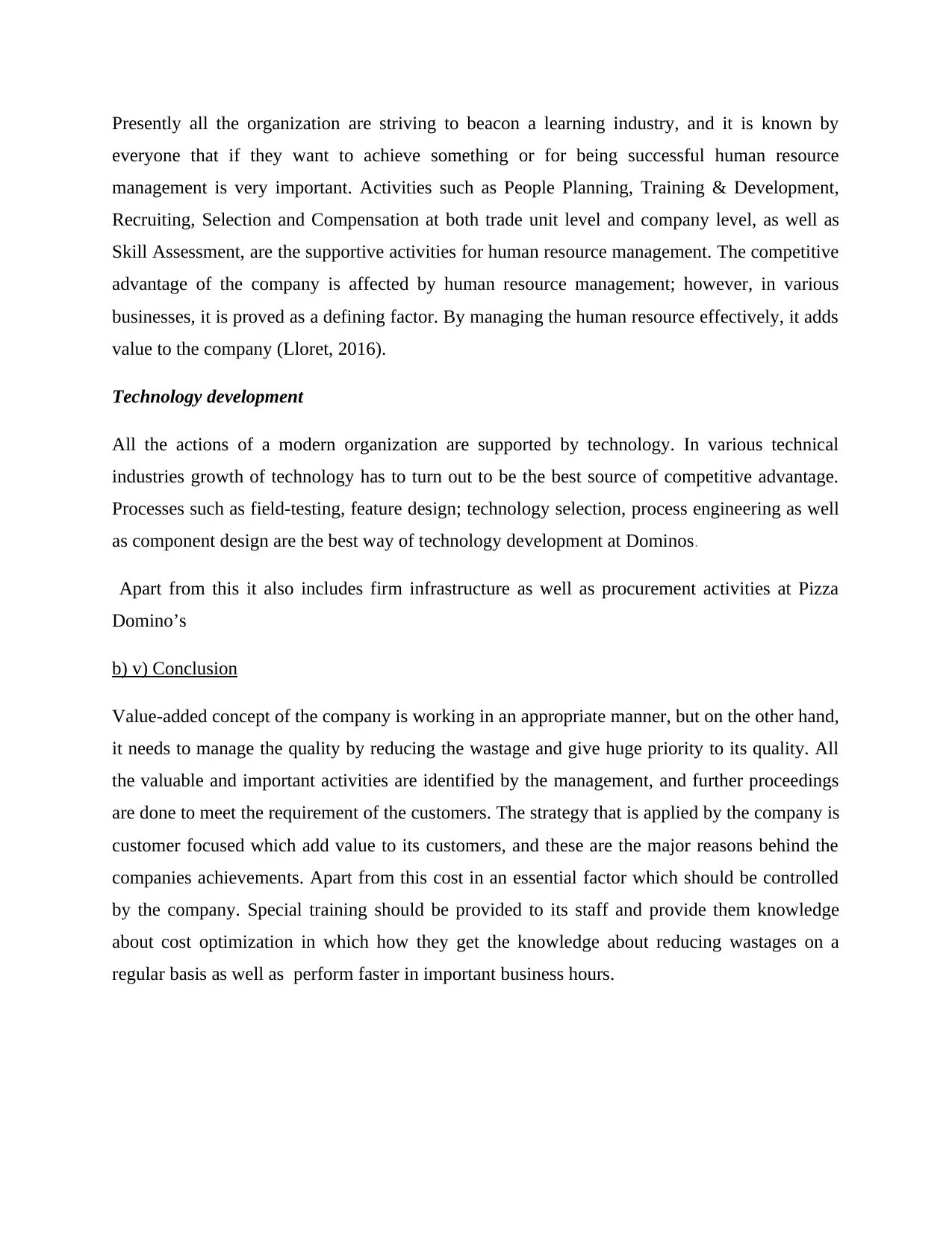
Presently all the organization are striving to beacon a learning industry, and it is known by
everyone that if they want to achieve something or for being successful human resource
management is very important. Activities such as People Planning, Training & Development,
Recruiting, Selection and Compensation at both trade unit level and company level, as well as
Skill Assessment, are the supportive activities for human resource management. The competitive
advantage of the company is affected by human resource management; however, in various
businesses, it is proved as a defining factor. By managing the human resource effectively, it adds
value to the company (Lloret, 2016).
Technology development
All the actions of a modern organization are supported by technology. In various technical
industries growth of technology has to turn out to be the best source of competitive advantage.
Processes such as field-testing, feature design; technology selection, process engineering as well
as component design are the best way of technology development at Dominos.
Apart from this it also includes firm infrastructure as well as procurement activities at Pizza
Domino’s
b) v) Conclusion
Value-added concept of the company is working in an appropriate manner, but on the other hand,
it needs to manage the quality by reducing the wastage and give huge priority to its quality. All
the valuable and important activities are identified by the management, and further proceedings
are done to meet the requirement of the customers. The strategy that is applied by the company is
customer focused which add value to its customers, and these are the major reasons behind the
companies achievements. Apart from this cost in an essential factor which should be controlled
by the company. Special training should be provided to its staff and provide them knowledge
about cost optimization in which how they get the knowledge about reducing wastages on a
regular basis as well as perform faster in important business hours.
everyone that if they want to achieve something or for being successful human resource
management is very important. Activities such as People Planning, Training & Development,
Recruiting, Selection and Compensation at both trade unit level and company level, as well as
Skill Assessment, are the supportive activities for human resource management. The competitive
advantage of the company is affected by human resource management; however, in various
businesses, it is proved as a defining factor. By managing the human resource effectively, it adds
value to the company (Lloret, 2016).
Technology development
All the actions of a modern organization are supported by technology. In various technical
industries growth of technology has to turn out to be the best source of competitive advantage.
Processes such as field-testing, feature design; technology selection, process engineering as well
as component design are the best way of technology development at Dominos.
Apart from this it also includes firm infrastructure as well as procurement activities at Pizza
Domino’s
b) v) Conclusion
Value-added concept of the company is working in an appropriate manner, but on the other hand,
it needs to manage the quality by reducing the wastage and give huge priority to its quality. All
the valuable and important activities are identified by the management, and further proceedings
are done to meet the requirement of the customers. The strategy that is applied by the company is
customer focused which add value to its customers, and these are the major reasons behind the
companies achievements. Apart from this cost in an essential factor which should be controlled
by the company. Special training should be provided to its staff and provide them knowledge
about cost optimization in which how they get the knowledge about reducing wastages on a
regular basis as well as perform faster in important business hours.
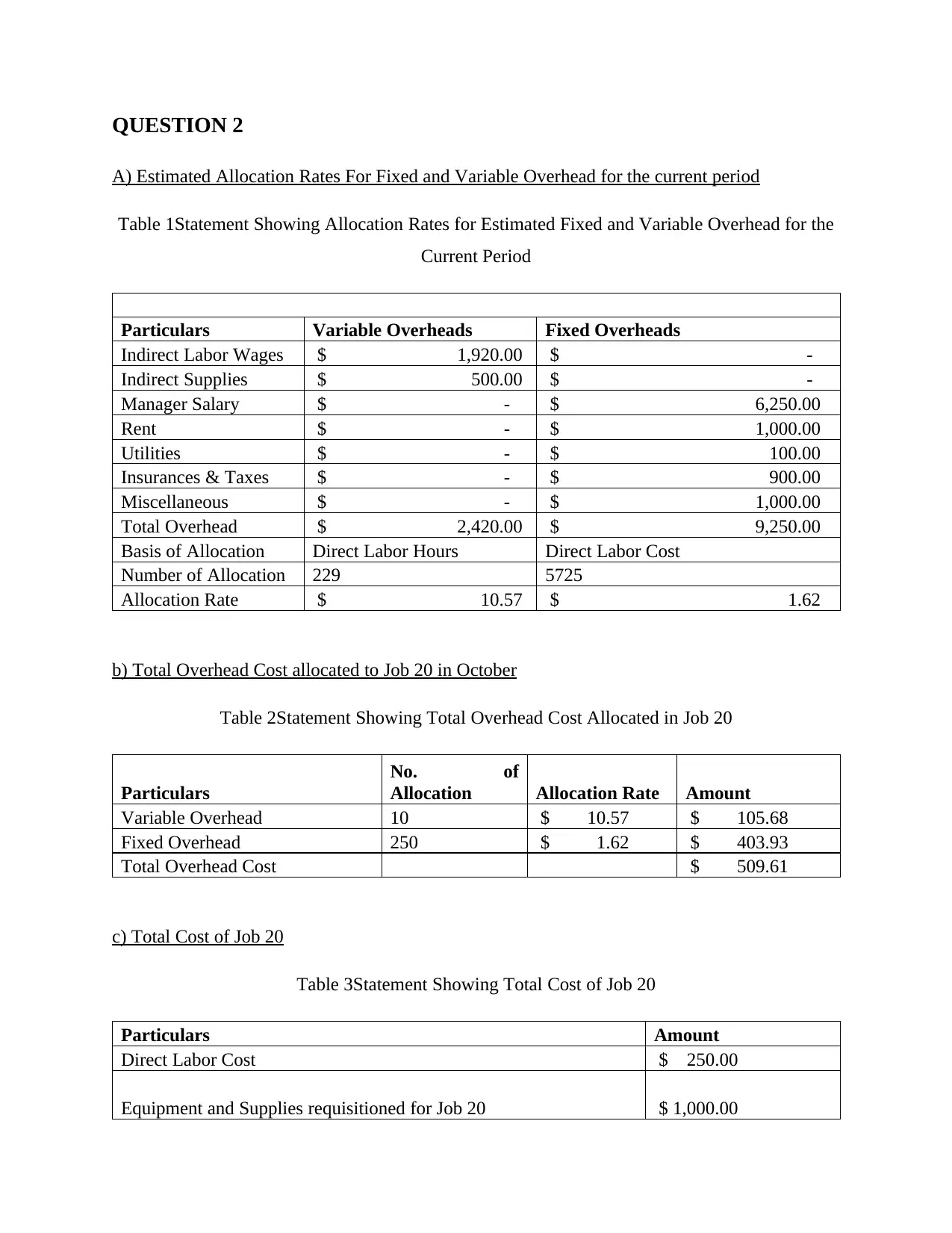
QUESTION 2
A) Estimated Allocation Rates For Fixed and Variable Overhead for the current period
Table 1Statement Showing Allocation Rates for Estimated Fixed and Variable Overhead for the
Current Period
Particulars Variable Overheads Fixed Overheads
Indirect Labor Wages $ 1,920.00 $ -
Indirect Supplies $ 500.00 $ -
Manager Salary $ - $ 6,250.00
Rent $ - $ 1,000.00
Utilities $ - $ 100.00
Insurances & Taxes $ - $ 900.00
Miscellaneous $ - $ 1,000.00
Total Overhead $ 2,420.00 $ 9,250.00
Basis of Allocation Direct Labor Hours Direct Labor Cost
Number of Allocation 229 5725
Allocation Rate $ 10.57 $ 1.62
b) Total Overhead Cost allocated to Job 20 in October
Table 2Statement Showing Total Overhead Cost Allocated in Job 20
Particulars
No. of
Allocation Allocation Rate Amount
Variable Overhead 10 $ 10.57 $ 105.68
Fixed Overhead 250 $ 1.62 $ 403.93
Total Overhead Cost $ 509.61
c) Total Cost of Job 20
Table 3Statement Showing Total Cost of Job 20
Particulars Amount
Direct Labor Cost $ 250.00
Equipment and Supplies requisitioned for Job 20 $ 1,000.00
A) Estimated Allocation Rates For Fixed and Variable Overhead for the current period
Table 1Statement Showing Allocation Rates for Estimated Fixed and Variable Overhead for the
Current Period
Particulars Variable Overheads Fixed Overheads
Indirect Labor Wages $ 1,920.00 $ -
Indirect Supplies $ 500.00 $ -
Manager Salary $ - $ 6,250.00
Rent $ - $ 1,000.00
Utilities $ - $ 100.00
Insurances & Taxes $ - $ 900.00
Miscellaneous $ - $ 1,000.00
Total Overhead $ 2,420.00 $ 9,250.00
Basis of Allocation Direct Labor Hours Direct Labor Cost
Number of Allocation 229 5725
Allocation Rate $ 10.57 $ 1.62
b) Total Overhead Cost allocated to Job 20 in October
Table 2Statement Showing Total Overhead Cost Allocated in Job 20
Particulars
No. of
Allocation Allocation Rate Amount
Variable Overhead 10 $ 10.57 $ 105.68
Fixed Overhead 250 $ 1.62 $ 403.93
Total Overhead Cost $ 509.61
c) Total Cost of Job 20
Table 3Statement Showing Total Cost of Job 20
Particulars Amount
Direct Labor Cost $ 250.00
Equipment and Supplies requisitioned for Job 20 $ 1,000.00
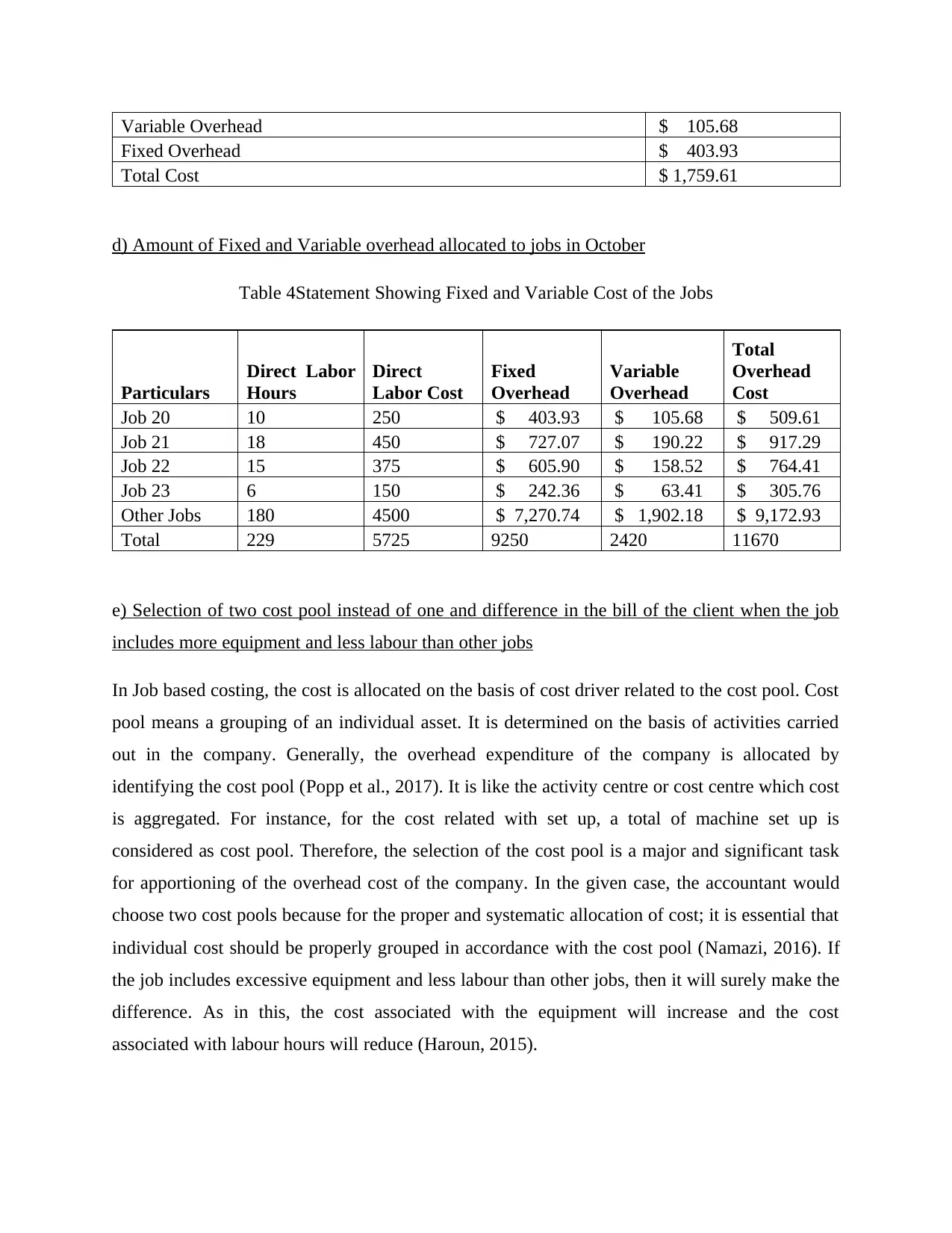
Variable Overhead $ 105.68
Fixed Overhead $ 403.93
Total Cost $ 1,759.61
d) Amount of Fixed and Variable overhead allocated to jobs in October
Table 4Statement Showing Fixed and Variable Cost of the Jobs
Particulars
Direct Labor
Hours
Direct
Labor Cost
Fixed
Overhead
Variable
Overhead
Total
Overhead
Cost
Job 20 10 250 $ 403.93 $ 105.68 $ 509.61
Job 21 18 450 $ 727.07 $ 190.22 $ 917.29
Job 22 15 375 $ 605.90 $ 158.52 $ 764.41
Job 23 6 150 $ 242.36 $ 63.41 $ 305.76
Other Jobs 180 4500 $ 7,270.74 $ 1,902.18 $ 9,172.93
Total 229 5725 9250 2420 11670
e) Selection of two cost pool instead of one and difference in the bill of the client when the job
includes more equipment and less labour than other jobs
In Job based costing, the cost is allocated on the basis of cost driver related to the cost pool. Cost
pool means a grouping of an individual asset. It is determined on the basis of activities carried
out in the company. Generally, the overhead expenditure of the company is allocated by
identifying the cost pool (Popp et al., 2017). It is like the activity centre or cost centre which cost
is aggregated. For instance, for the cost related with set up, a total of machine set up is
considered as cost pool. Therefore, the selection of the cost pool is a major and significant task
for apportioning of the overhead cost of the company. In the given case, the accountant would
choose two cost pools because for the proper and systematic allocation of cost; it is essential that
individual cost should be properly grouped in accordance with the cost pool (Namazi, 2016). If
the job includes excessive equipment and less labour than other jobs, then it will surely make the
difference. As in this, the cost associated with the equipment will increase and the cost
associated with labour hours will reduce (Haroun, 2015).
Fixed Overhead $ 403.93
Total Cost $ 1,759.61
d) Amount of Fixed and Variable overhead allocated to jobs in October
Table 4Statement Showing Fixed and Variable Cost of the Jobs
Particulars
Direct Labor
Hours
Direct
Labor Cost
Fixed
Overhead
Variable
Overhead
Total
Overhead
Cost
Job 20 10 250 $ 403.93 $ 105.68 $ 509.61
Job 21 18 450 $ 727.07 $ 190.22 $ 917.29
Job 22 15 375 $ 605.90 $ 158.52 $ 764.41
Job 23 6 150 $ 242.36 $ 63.41 $ 305.76
Other Jobs 180 4500 $ 7,270.74 $ 1,902.18 $ 9,172.93
Total 229 5725 9250 2420 11670
e) Selection of two cost pool instead of one and difference in the bill of the client when the job
includes more equipment and less labour than other jobs
In Job based costing, the cost is allocated on the basis of cost driver related to the cost pool. Cost
pool means a grouping of an individual asset. It is determined on the basis of activities carried
out in the company. Generally, the overhead expenditure of the company is allocated by
identifying the cost pool (Popp et al., 2017). It is like the activity centre or cost centre which cost
is aggregated. For instance, for the cost related with set up, a total of machine set up is
considered as cost pool. Therefore, the selection of the cost pool is a major and significant task
for apportioning of the overhead cost of the company. In the given case, the accountant would
choose two cost pools because for the proper and systematic allocation of cost; it is essential that
individual cost should be properly grouped in accordance with the cost pool (Namazi, 2016). If
the job includes excessive equipment and less labour than other jobs, then it will surely make the
difference. As in this, the cost associated with the equipment will increase and the cost
associated with labour hours will reduce (Haroun, 2015).
Secure Best Marks with AI Grader
Need help grading? Try our AI Grader for instant feedback on your assignments.
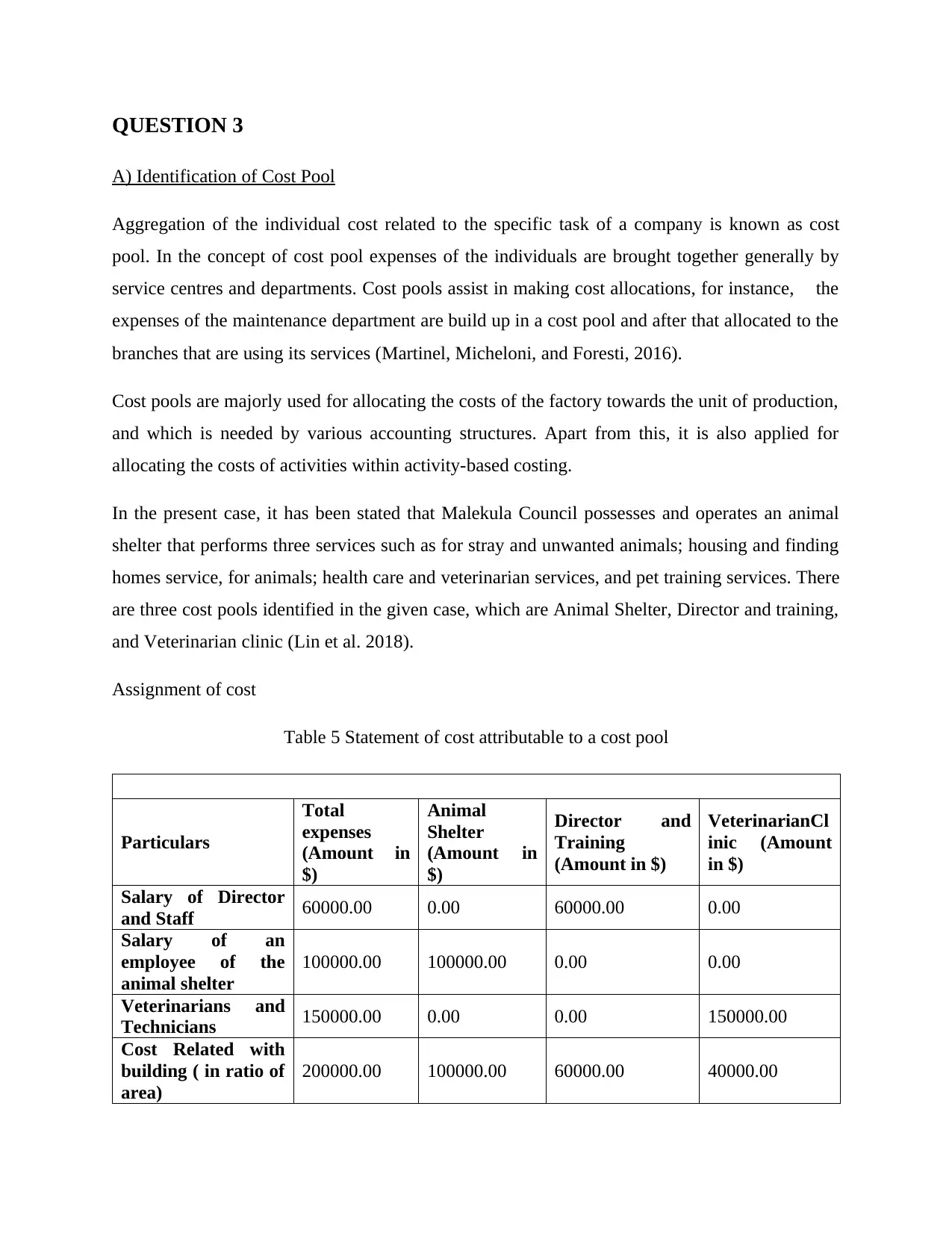
QUESTION 3
A) Identification of Cost Pool
Aggregation of the individual cost related to the specific task of a company is known as cost
pool. In the concept of cost pool expenses of the individuals are brought together generally by
service centres and departments. Cost pools assist in making cost allocations, for instance, the
expenses of the maintenance department are build up in a cost pool and after that allocated to the
branches that are using its services (Martinel, Micheloni, and Foresti, 2016).
Cost pools are majorly used for allocating the costs of the factory towards the unit of production,
and which is needed by various accounting structures. Apart from this, it is also applied for
allocating the costs of activities within activity-based costing.
In the present case, it has been stated that Malekula Council possesses and operates an animal
shelter that performs three services such as for stray and unwanted animals; housing and finding
homes service, for animals; health care and veterinarian services, and pet training services. There
are three cost pools identified in the given case, which are Animal Shelter, Director and training,
and Veterinarian clinic (Lin et al. 2018).
Assignment of cost
Table 5 Statement of cost attributable to a cost pool
Particulars
Total
expenses
(Amount in
$)
Animal
Shelter
(Amount in
$)
Director and
Training
(Amount in $)
VeterinarianCl
inic (Amount
in $)
Salary of Director
and Staff 60000.00 0.00 60000.00 0.00
Salary of an
employee of the
animal shelter
100000.00 100000.00 0.00 0.00
Veterinarians and
Technicians 150000.00 0.00 0.00 150000.00
Cost Related with
building ( in ratio of
area)
200000.00 100000.00 60000.00 40000.00
A) Identification of Cost Pool
Aggregation of the individual cost related to the specific task of a company is known as cost
pool. In the concept of cost pool expenses of the individuals are brought together generally by
service centres and departments. Cost pools assist in making cost allocations, for instance, the
expenses of the maintenance department are build up in a cost pool and after that allocated to the
branches that are using its services (Martinel, Micheloni, and Foresti, 2016).
Cost pools are majorly used for allocating the costs of the factory towards the unit of production,
and which is needed by various accounting structures. Apart from this, it is also applied for
allocating the costs of activities within activity-based costing.
In the present case, it has been stated that Malekula Council possesses and operates an animal
shelter that performs three services such as for stray and unwanted animals; housing and finding
homes service, for animals; health care and veterinarian services, and pet training services. There
are three cost pools identified in the given case, which are Animal Shelter, Director and training,
and Veterinarian clinic (Lin et al. 2018).
Assignment of cost
Table 5 Statement of cost attributable to a cost pool
Particulars
Total
expenses
(Amount in
$)
Animal
Shelter
(Amount in
$)
Director and
Training
(Amount in $)
VeterinarianCl
inic (Amount
in $)
Salary of Director
and Staff 60000.00 0.00 60000.00 0.00
Salary of an
employee of the
animal shelter
100000.00 100000.00 0.00 0.00
Veterinarians and
Technicians 150000.00 0.00 0.00 150000.00
Cost Related with
building ( in ratio of
area)
200000.00 100000.00 60000.00 40000.00
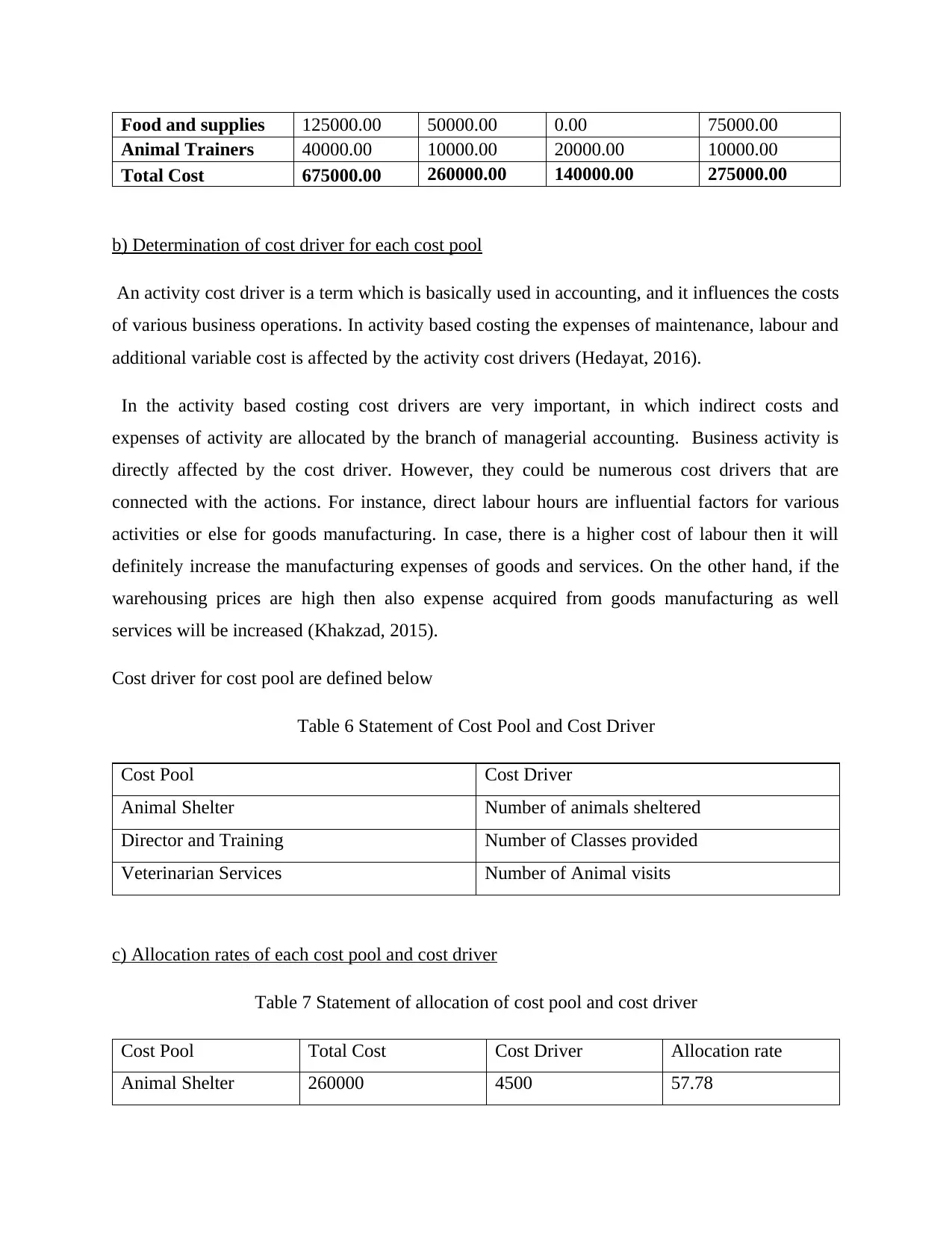
Food and supplies 125000.00 50000.00 0.00 75000.00
Animal Trainers 40000.00 10000.00 20000.00 10000.00
Total Cost 675000.00 260000.00 140000.00 275000.00
b) Determination of cost driver for each cost pool
An activity cost driver is a term which is basically used in accounting, and it influences the costs
of various business operations. In activity based costing the expenses of maintenance, labour and
additional variable cost is affected by the activity cost drivers (Hedayat, 2016).
In the activity based costing cost drivers are very important, in which indirect costs and
expenses of activity are allocated by the branch of managerial accounting. Business activity is
directly affected by the cost driver. However, they could be numerous cost drivers that are
connected with the actions. For instance, direct labour hours are influential factors for various
activities or else for goods manufacturing. In case, there is a higher cost of labour then it will
definitely increase the manufacturing expenses of goods and services. On the other hand, if the
warehousing prices are high then also expense acquired from goods manufacturing as well
services will be increased (Khakzad, 2015).
Cost driver for cost pool are defined below
Table 6 Statement of Cost Pool and Cost Driver
Cost Pool Cost Driver
Animal Shelter Number of animals sheltered
Director and Training Number of Classes provided
Veterinarian Services Number of Animal visits
c) Allocation rates of each cost pool and cost driver
Table 7 Statement of allocation of cost pool and cost driver
Cost Pool Total Cost Cost Driver Allocation rate
Animal Shelter 260000 4500 57.78
Animal Trainers 40000.00 10000.00 20000.00 10000.00
Total Cost 675000.00 260000.00 140000.00 275000.00
b) Determination of cost driver for each cost pool
An activity cost driver is a term which is basically used in accounting, and it influences the costs
of various business operations. In activity based costing the expenses of maintenance, labour and
additional variable cost is affected by the activity cost drivers (Hedayat, 2016).
In the activity based costing cost drivers are very important, in which indirect costs and
expenses of activity are allocated by the branch of managerial accounting. Business activity is
directly affected by the cost driver. However, they could be numerous cost drivers that are
connected with the actions. For instance, direct labour hours are influential factors for various
activities or else for goods manufacturing. In case, there is a higher cost of labour then it will
definitely increase the manufacturing expenses of goods and services. On the other hand, if the
warehousing prices are high then also expense acquired from goods manufacturing as well
services will be increased (Khakzad, 2015).
Cost driver for cost pool are defined below
Table 6 Statement of Cost Pool and Cost Driver
Cost Pool Cost Driver
Animal Shelter Number of animals sheltered
Director and Training Number of Classes provided
Veterinarian Services Number of Animal visits
c) Allocation rates of each cost pool and cost driver
Table 7 Statement of allocation of cost pool and cost driver
Cost Pool Total Cost Cost Driver Allocation rate
Animal Shelter 260000 4500 57.78
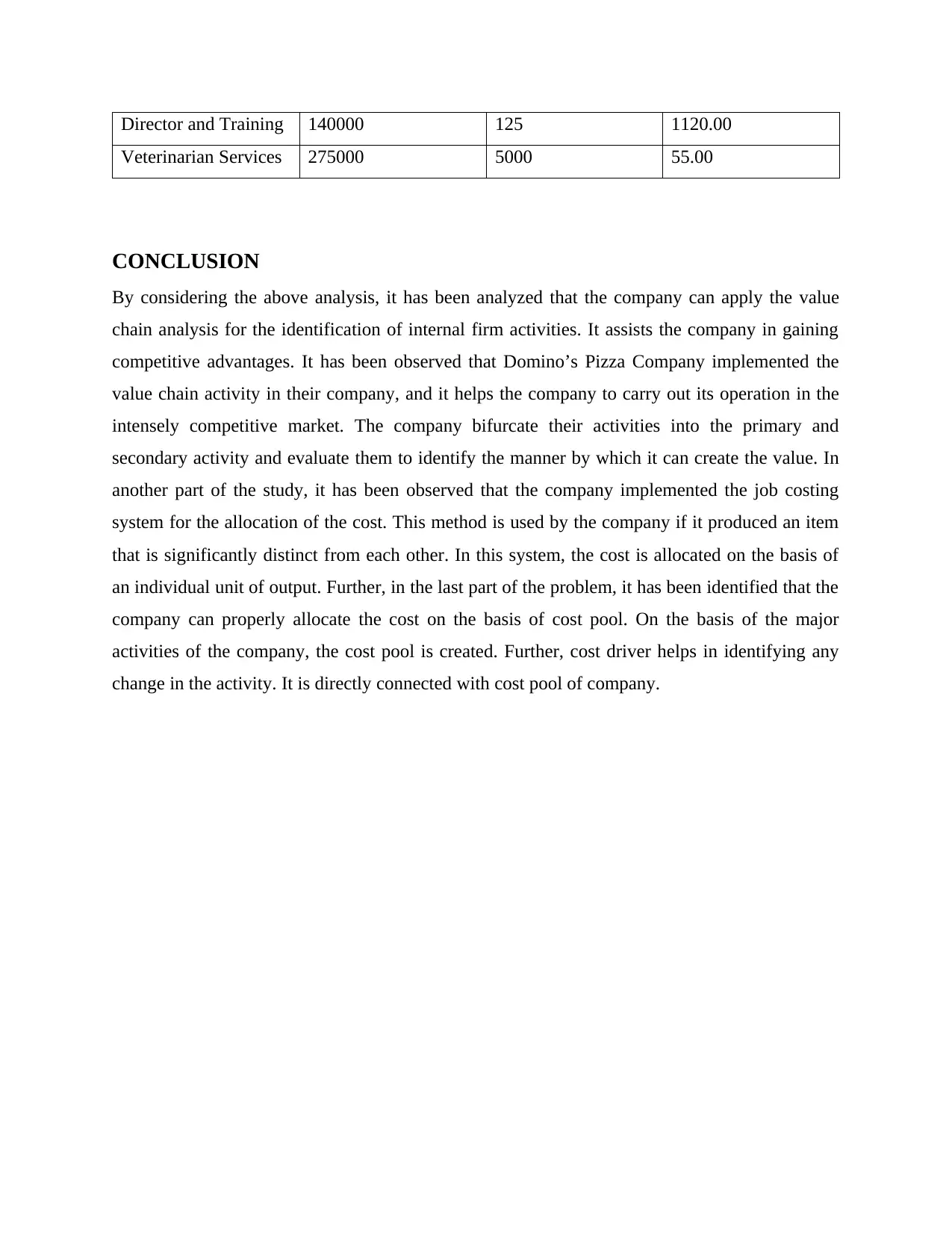
Director and Training 140000 125 1120.00
Veterinarian Services 275000 5000 55.00
CONCLUSION
By considering the above analysis, it has been analyzed that the company can apply the value
chain analysis for the identification of internal firm activities. It assists the company in gaining
competitive advantages. It has been observed that Domino’s Pizza Company implemented the
value chain activity in their company, and it helps the company to carry out its operation in the
intensely competitive market. The company bifurcate their activities into the primary and
secondary activity and evaluate them to identify the manner by which it can create the value. In
another part of the study, it has been observed that the company implemented the job costing
system for the allocation of the cost. This method is used by the company if it produced an item
that is significantly distinct from each other. In this system, the cost is allocated on the basis of
an individual unit of output. Further, in the last part of the problem, it has been identified that the
company can properly allocate the cost on the basis of cost pool. On the basis of the major
activities of the company, the cost pool is created. Further, cost driver helps in identifying any
change in the activity. It is directly connected with cost pool of company.
Veterinarian Services 275000 5000 55.00
CONCLUSION
By considering the above analysis, it has been analyzed that the company can apply the value
chain analysis for the identification of internal firm activities. It assists the company in gaining
competitive advantages. It has been observed that Domino’s Pizza Company implemented the
value chain activity in their company, and it helps the company to carry out its operation in the
intensely competitive market. The company bifurcate their activities into the primary and
secondary activity and evaluate them to identify the manner by which it can create the value. In
another part of the study, it has been observed that the company implemented the job costing
system for the allocation of the cost. This method is used by the company if it produced an item
that is significantly distinct from each other. In this system, the cost is allocated on the basis of
an individual unit of output. Further, in the last part of the problem, it has been identified that the
company can properly allocate the cost on the basis of cost pool. On the basis of the major
activities of the company, the cost pool is created. Further, cost driver helps in identifying any
change in the activity. It is directly connected with cost pool of company.
Paraphrase This Document
Need a fresh take? Get an instant paraphrase of this document with our AI Paraphraser
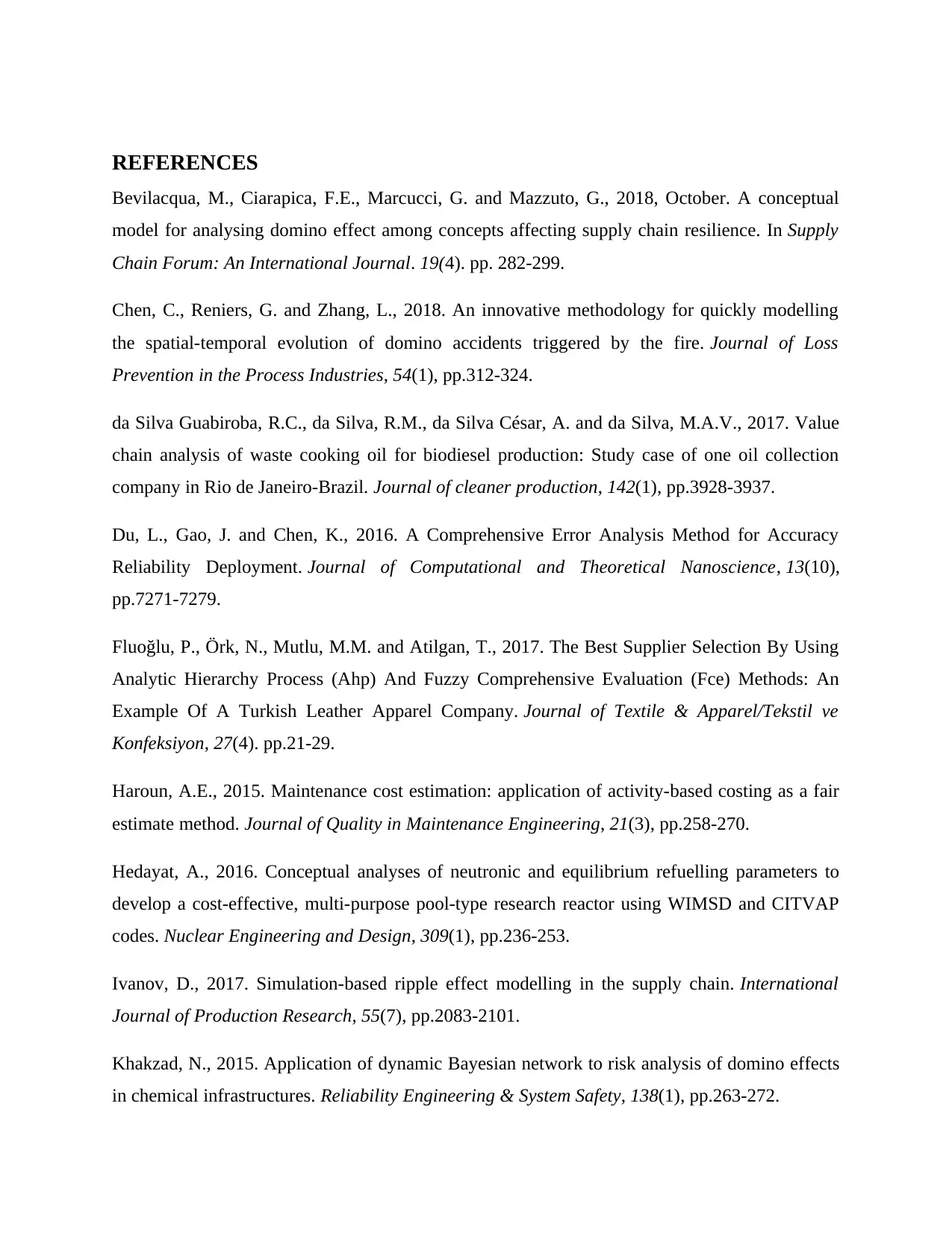
REFERENCES
Bevilacqua, M., Ciarapica, F.E., Marcucci, G. and Mazzuto, G., 2018, October. A conceptual
model for analysing domino effect among concepts affecting supply chain resilience. In Supply
Chain Forum: An International Journal. 19(4). pp. 282-299.
Chen, C., Reniers, G. and Zhang, L., 2018. An innovative methodology for quickly modelling
the spatial-temporal evolution of domino accidents triggered by the fire. Journal of Loss
Prevention in the Process Industries, 54(1), pp.312-324.
da Silva Guabiroba, R.C., da Silva, R.M., da Silva César, A. and da Silva, M.A.V., 2017. Value
chain analysis of waste cooking oil for biodiesel production: Study case of one oil collection
company in Rio de Janeiro-Brazil. Journal of cleaner production, 142(1), pp.3928-3937.
Du, L., Gao, J. and Chen, K., 2016. A Comprehensive Error Analysis Method for Accuracy
Reliability Deployment. Journal of Computational and Theoretical Nanoscience, 13(10),
pp.7271-7279.
Fluoğlu, P., Örk, N., Mutlu, M.M. and Atilgan, T., 2017. The Best Supplier Selection By Using
Analytic Hierarchy Process (Ahp) And Fuzzy Comprehensive Evaluation (Fce) Methods: An
Example Of A Turkish Leather Apparel Company. Journal of Textile & Apparel/Tekstil ve
Konfeksiyon, 27(4). pp.21-29.
Haroun, A.E., 2015. Maintenance cost estimation: application of activity-based costing as a fair
estimate method. Journal of Quality in Maintenance Engineering, 21(3), pp.258-270.
Hedayat, A., 2016. Conceptual analyses of neutronic and equilibrium refuelling parameters to
develop a cost-effective, multi-purpose pool-type research reactor using WIMSD and CITVAP
codes. Nuclear Engineering and Design, 309(1), pp.236-253.
Ivanov, D., 2017. Simulation-based ripple effect modelling in the supply chain. International
Journal of Production Research, 55(7), pp.2083-2101.
Khakzad, N., 2015. Application of dynamic Bayesian network to risk analysis of domino effects
in chemical infrastructures. Reliability Engineering & System Safety, 138(1), pp.263-272.
Bevilacqua, M., Ciarapica, F.E., Marcucci, G. and Mazzuto, G., 2018, October. A conceptual
model for analysing domino effect among concepts affecting supply chain resilience. In Supply
Chain Forum: An International Journal. 19(4). pp. 282-299.
Chen, C., Reniers, G. and Zhang, L., 2018. An innovative methodology for quickly modelling
the spatial-temporal evolution of domino accidents triggered by the fire. Journal of Loss
Prevention in the Process Industries, 54(1), pp.312-324.
da Silva Guabiroba, R.C., da Silva, R.M., da Silva César, A. and da Silva, M.A.V., 2017. Value
chain analysis of waste cooking oil for biodiesel production: Study case of one oil collection
company in Rio de Janeiro-Brazil. Journal of cleaner production, 142(1), pp.3928-3937.
Du, L., Gao, J. and Chen, K., 2016. A Comprehensive Error Analysis Method for Accuracy
Reliability Deployment. Journal of Computational and Theoretical Nanoscience, 13(10),
pp.7271-7279.
Fluoğlu, P., Örk, N., Mutlu, M.M. and Atilgan, T., 2017. The Best Supplier Selection By Using
Analytic Hierarchy Process (Ahp) And Fuzzy Comprehensive Evaluation (Fce) Methods: An
Example Of A Turkish Leather Apparel Company. Journal of Textile & Apparel/Tekstil ve
Konfeksiyon, 27(4). pp.21-29.
Haroun, A.E., 2015. Maintenance cost estimation: application of activity-based costing as a fair
estimate method. Journal of Quality in Maintenance Engineering, 21(3), pp.258-270.
Hedayat, A., 2016. Conceptual analyses of neutronic and equilibrium refuelling parameters to
develop a cost-effective, multi-purpose pool-type research reactor using WIMSD and CITVAP
codes. Nuclear Engineering and Design, 309(1), pp.236-253.
Ivanov, D., 2017. Simulation-based ripple effect modelling in the supply chain. International
Journal of Production Research, 55(7), pp.2083-2101.
Khakzad, N., 2015. Application of dynamic Bayesian network to risk analysis of domino effects
in chemical infrastructures. Reliability Engineering & System Safety, 138(1), pp.263-272.
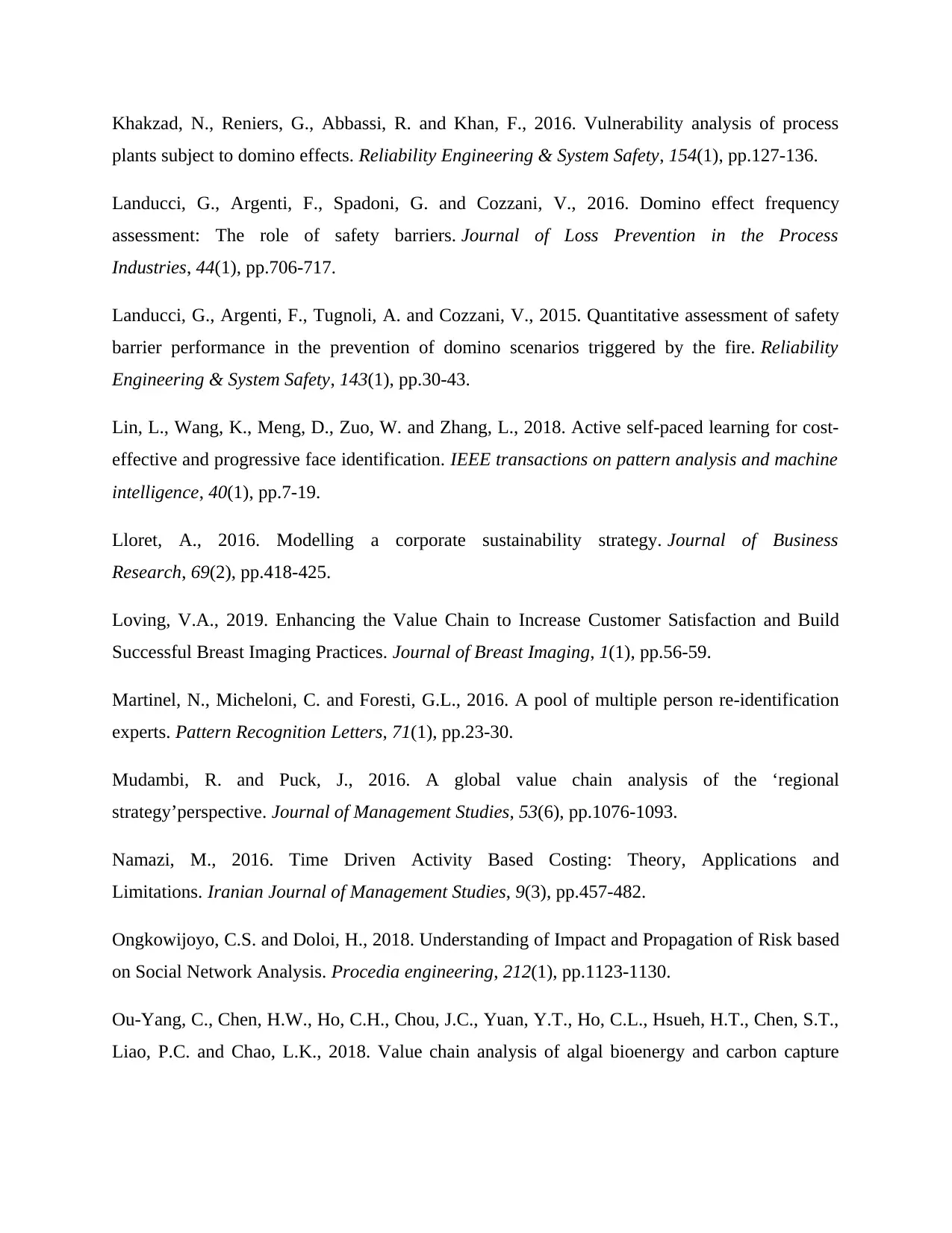
Khakzad, N., Reniers, G., Abbassi, R. and Khan, F., 2016. Vulnerability analysis of process
plants subject to domino effects. Reliability Engineering & System Safety, 154(1), pp.127-136.
Landucci, G., Argenti, F., Spadoni, G. and Cozzani, V., 2016. Domino effect frequency
assessment: The role of safety barriers. Journal of Loss Prevention in the Process
Industries, 44(1), pp.706-717.
Landucci, G., Argenti, F., Tugnoli, A. and Cozzani, V., 2015. Quantitative assessment of safety
barrier performance in the prevention of domino scenarios triggered by the fire. Reliability
Engineering & System Safety, 143(1), pp.30-43.
Lin, L., Wang, K., Meng, D., Zuo, W. and Zhang, L., 2018. Active self-paced learning for cost-
effective and progressive face identification. IEEE transactions on pattern analysis and machine
intelligence, 40(1), pp.7-19.
Lloret, A., 2016. Modelling a corporate sustainability strategy. Journal of Business
Research, 69(2), pp.418-425.
Loving, V.A., 2019. Enhancing the Value Chain to Increase Customer Satisfaction and Build
Successful Breast Imaging Practices. Journal of Breast Imaging, 1(1), pp.56-59.
Martinel, N., Micheloni, C. and Foresti, G.L., 2016. A pool of multiple person re-identification
experts. Pattern Recognition Letters, 71(1), pp.23-30.
Mudambi, R. and Puck, J., 2016. A global value chain analysis of the ‘regional
strategy’perspective. Journal of Management Studies, 53(6), pp.1076-1093.
Namazi, M., 2016. Time Driven Activity Based Costing: Theory, Applications and
Limitations. Iranian Journal of Management Studies, 9(3), pp.457-482.
Ongkowijoyo, C.S. and Doloi, H., 2018. Understanding of Impact and Propagation of Risk based
on Social Network Analysis. Procedia engineering, 212(1), pp.1123-1130.
Ou-Yang, C., Chen, H.W., Ho, C.H., Chou, J.C., Yuan, Y.T., Ho, C.L., Hsueh, H.T., Chen, S.T.,
Liao, P.C. and Chao, L.K., 2018. Value chain analysis of algal bioenergy and carbon capture
plants subject to domino effects. Reliability Engineering & System Safety, 154(1), pp.127-136.
Landucci, G., Argenti, F., Spadoni, G. and Cozzani, V., 2016. Domino effect frequency
assessment: The role of safety barriers. Journal of Loss Prevention in the Process
Industries, 44(1), pp.706-717.
Landucci, G., Argenti, F., Tugnoli, A. and Cozzani, V., 2015. Quantitative assessment of safety
barrier performance in the prevention of domino scenarios triggered by the fire. Reliability
Engineering & System Safety, 143(1), pp.30-43.
Lin, L., Wang, K., Meng, D., Zuo, W. and Zhang, L., 2018. Active self-paced learning for cost-
effective and progressive face identification. IEEE transactions on pattern analysis and machine
intelligence, 40(1), pp.7-19.
Lloret, A., 2016. Modelling a corporate sustainability strategy. Journal of Business
Research, 69(2), pp.418-425.
Loving, V.A., 2019. Enhancing the Value Chain to Increase Customer Satisfaction and Build
Successful Breast Imaging Practices. Journal of Breast Imaging, 1(1), pp.56-59.
Martinel, N., Micheloni, C. and Foresti, G.L., 2016. A pool of multiple person re-identification
experts. Pattern Recognition Letters, 71(1), pp.23-30.
Mudambi, R. and Puck, J., 2016. A global value chain analysis of the ‘regional
strategy’perspective. Journal of Management Studies, 53(6), pp.1076-1093.
Namazi, M., 2016. Time Driven Activity Based Costing: Theory, Applications and
Limitations. Iranian Journal of Management Studies, 9(3), pp.457-482.
Ongkowijoyo, C.S. and Doloi, H., 2018. Understanding of Impact and Propagation of Risk based
on Social Network Analysis. Procedia engineering, 212(1), pp.1123-1130.
Ou-Yang, C., Chen, H.W., Ho, C.H., Chou, J.C., Yuan, Y.T., Ho, C.L., Hsueh, H.T., Chen, S.T.,
Liao, P.C. and Chao, L.K., 2018. Value chain analysis of algal bioenergy and carbon capture
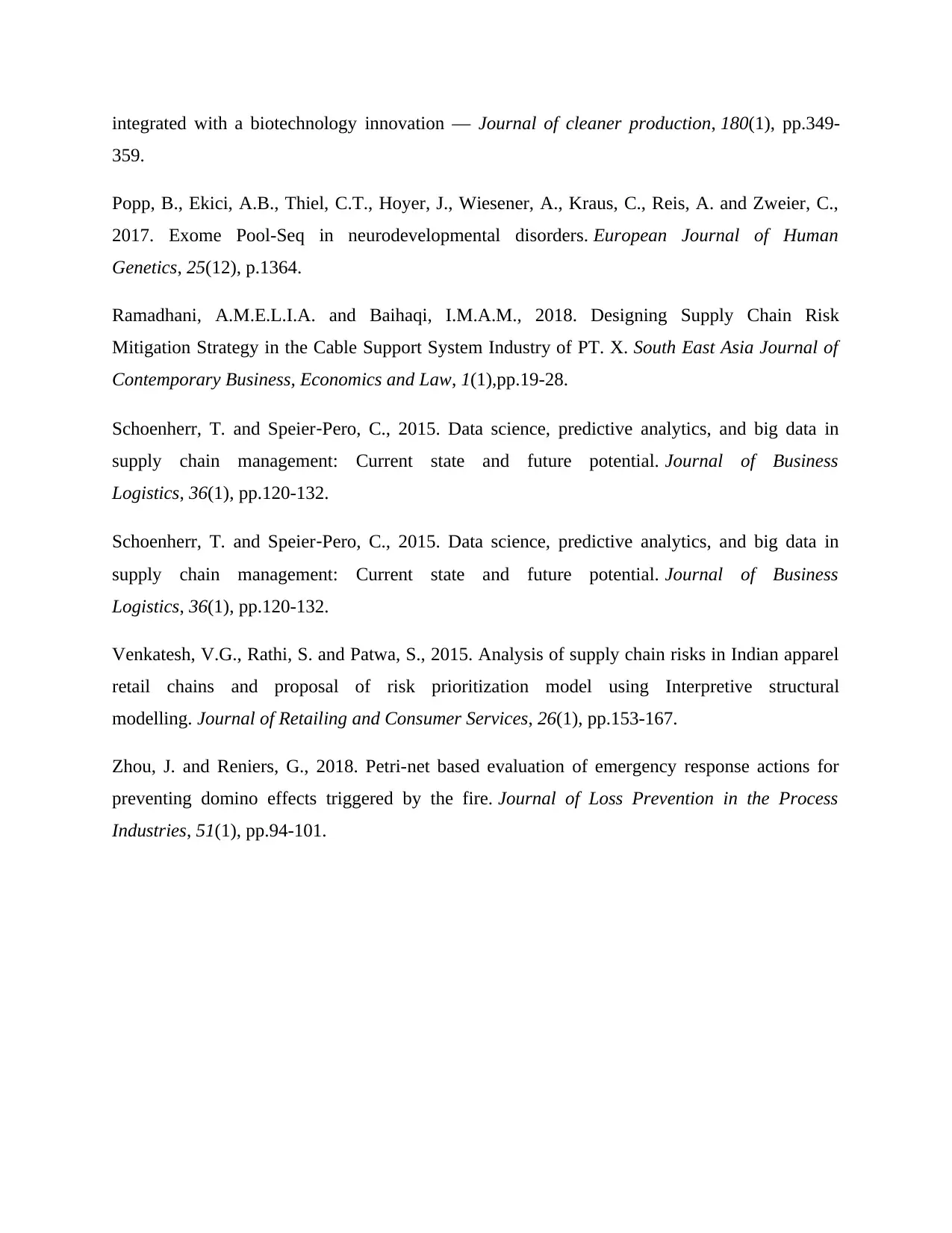
integrated with a biotechnology innovation — Journal of cleaner production, 180(1), pp.349-
359.
Popp, B., Ekici, A.B., Thiel, C.T., Hoyer, J., Wiesener, A., Kraus, C., Reis, A. and Zweier, C.,
2017. Exome Pool-Seq in neurodevelopmental disorders. European Journal of Human
Genetics, 25(12), p.1364.
Ramadhani, A.M.E.L.I.A. and Baihaqi, I.M.A.M., 2018. Designing Supply Chain Risk
Mitigation Strategy in the Cable Support System Industry of PT. X. South East Asia Journal of
Contemporary Business, Economics and Law, 1(1),pp.19-28.
Schoenherr, T. and Speier‐Pero, C., 2015. Data science, predictive analytics, and big data in
supply chain management: Current state and future potential. Journal of Business
Logistics, 36(1), pp.120-132.
Schoenherr, T. and Speier‐Pero, C., 2015. Data science, predictive analytics, and big data in
supply chain management: Current state and future potential. Journal of Business
Logistics, 36(1), pp.120-132.
Venkatesh, V.G., Rathi, S. and Patwa, S., 2015. Analysis of supply chain risks in Indian apparel
retail chains and proposal of risk prioritization model using Interpretive structural
modelling. Journal of Retailing and Consumer Services, 26(1), pp.153-167.
Zhou, J. and Reniers, G., 2018. Petri-net based evaluation of emergency response actions for
preventing domino effects triggered by the fire. Journal of Loss Prevention in the Process
Industries, 51(1), pp.94-101.
359.
Popp, B., Ekici, A.B., Thiel, C.T., Hoyer, J., Wiesener, A., Kraus, C., Reis, A. and Zweier, C.,
2017. Exome Pool-Seq in neurodevelopmental disorders. European Journal of Human
Genetics, 25(12), p.1364.
Ramadhani, A.M.E.L.I.A. and Baihaqi, I.M.A.M., 2018. Designing Supply Chain Risk
Mitigation Strategy in the Cable Support System Industry of PT. X. South East Asia Journal of
Contemporary Business, Economics and Law, 1(1),pp.19-28.
Schoenherr, T. and Speier‐Pero, C., 2015. Data science, predictive analytics, and big data in
supply chain management: Current state and future potential. Journal of Business
Logistics, 36(1), pp.120-132.
Schoenherr, T. and Speier‐Pero, C., 2015. Data science, predictive analytics, and big data in
supply chain management: Current state and future potential. Journal of Business
Logistics, 36(1), pp.120-132.
Venkatesh, V.G., Rathi, S. and Patwa, S., 2015. Analysis of supply chain risks in Indian apparel
retail chains and proposal of risk prioritization model using Interpretive structural
modelling. Journal of Retailing and Consumer Services, 26(1), pp.153-167.
Zhou, J. and Reniers, G., 2018. Petri-net based evaluation of emergency response actions for
preventing domino effects triggered by the fire. Journal of Loss Prevention in the Process
Industries, 51(1), pp.94-101.
1 out of 16
Related Documents
Your All-in-One AI-Powered Toolkit for Academic Success.
+13062052269
info@desklib.com
Available 24*7 on WhatsApp / Email
![[object Object]](/_next/static/media/star-bottom.7253800d.svg)
Unlock your academic potential
© 2024 | Zucol Services PVT LTD | All rights reserved.





